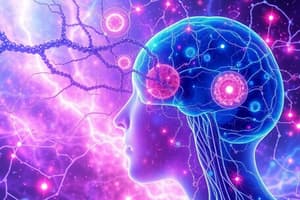Podcast
Questions and Answers
What is a characteristic of an agonist that distinguishes it from an antagonist?
What is a characteristic of an agonist that distinguishes it from an antagonist?
- High intrinsic activity (correct)
- No binding to receptor
- No efficacy
- Low affinity
What type of antagonism is characterized by the antagonist binding to the receptor and staying bound, making it irreversible?
What type of antagonism is characterized by the antagonist binding to the receptor and staying bound, making it irreversible?
- Noncompetitive antagonism (correct)
- Up regulation
- Competitive antagonism
- Desensitization
What is the effect of an agonist on the receptor, in terms of desensitization?
What is the effect of an agonist on the receptor, in terms of desensitization?
- Desensitization of receptors (correct)
- No effect on receptors
- Up regulation of receptors
- Increased signal transduction
What is the main difference between a full agonist and a partial agonist?
What is the main difference between a full agonist and a partial agonist?
What is the result of increasing the agonist concentration in the presence of a competitive antagonist?
What is the result of increasing the agonist concentration in the presence of a competitive antagonist?
What type of signal transduction is characterized by being speedy?
What type of signal transduction is characterized by being speedy?
What is the primary mechanism by which many drugs interact with biological systems?
What is the primary mechanism by which many drugs interact with biological systems?
What is the term for the ability of a drug to bind with receptors?
What is the term for the ability of a drug to bind with receptors?
What type of drug is propranolol, based on its mechanism of action?
What type of drug is propranolol, based on its mechanism of action?
A drug with high affinity binding is most likely to:
A drug with high affinity binding is most likely to:
What determines the degree of response to a drug, independent of its affinity?
What determines the degree of response to a drug, independent of its affinity?
Salbutamol is an example of a type of drug that:
Salbutamol is an example of a type of drug that:
What is the result of Ach binding to sites on α subunits?
What is the result of Ach binding to sites on α subunits?
What is the characteristic of the onset and offset of responses through nicotinic Ach receptors?
What is the characteristic of the onset and offset of responses through nicotinic Ach receptors?
What is the typical structure of enzymatic receptors?
What is the typical structure of enzymatic receptors?
What is the result of the binding of ligand to the extracellular domain of enzymatic receptors?
What is the result of the binding of ligand to the extracellular domain of enzymatic receptors?
What is an example of a ligand that uses a single type of receptor to trigger multiple biochemical processes?
What is an example of a ligand that uses a single type of receptor to trigger multiple biochemical processes?
What is the result of the binding of EGF to its receptor?
What is the result of the binding of EGF to its receptor?
What is the characteristic of the domain structure of the EGF receptor?
What is the characteristic of the domain structure of the EGF receptor?
Flashcards are hidden until you start studying
Study Notes
Synaptic Transmission
- A synaptic cleft is the gap between two neurons, where chemical transmission occurs.
- High affinity binding: the ligand binds well and remains bound long enough to activate the receptor.
- Low affinity binding: the ligand binds less well and may not remain bound long enough to activate the receptor.
Agonists and Antagonists
- Agonist: has affinity and intrinsic activity, producing a response.
- Antagonist: has affinity but no intrinsic activity, blocking the response.
- Partial agonist: has affinity and less intrinsic activity, producing a partial response.
- Competitive antagonists: compete with agonists for receptors, and can be overcome with increasing agonist concentration.
- Noncompetitive antagonists: bind to receptors and stay bound, reducing the apparent affinity of agonists.
Agonist Drugs
- Full agonist: has maximal efficacy.
- Partial agonist: has less than maximal efficacy.
- Agonist dose-response curves: show the response to different doses of agonist drugs.
Antagonist Drugs
- Competitive antagonists: reduce the apparent affinity of agonists.
- Noncompetitive antagonists: bind to receptors and stay bound, reducing the response.
Desensitization
- Agonists tend to desensitize receptors, reducing their number or signal transduction.
- Antagonists tend to up-regulate receptors.
Signal Transduction
- Enzyme-linked receptors: involve multiple actions.
- Ion channel-linked receptors: involve speedy actions.
- Pharmacodynamics: the effect of drugs on biological systems.
Pharmacodynamics
- The effect of drugs on the body.
- Mechanism of drug action.
- Many drugs inhibit enzymes, controlling metabolic processes.
- Some drugs bind to proteins or the genome.
- Most drugs act on receptors, binding to specific sites and triggering a response.
Drug Receptor
- A macromolecular component of a cell that interacts with a drug to produce a response.
- Usually a protein.
- Affinity: the ability of a drug to bind to a receptor.
- Intrinsic activity (efficacy): the ability of a drug to activate a receptor after binding.
Receptor Types
- Nicotinic Ach receptor: a ligand-gated ion channel.
- Enzymatic receptors: polypeptides with extracellular hormone binding and cytoplasmic enzyme domains.
- Examples: insulin, epidermal growth factor (EGF), platelet-derived growth factor (PDGF), and atrial natriuretic peptide (ANP) receptors.
Studying That Suits You
Use AI to generate personalized quizzes and flashcards to suit your learning preferences.




